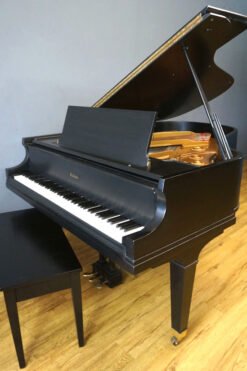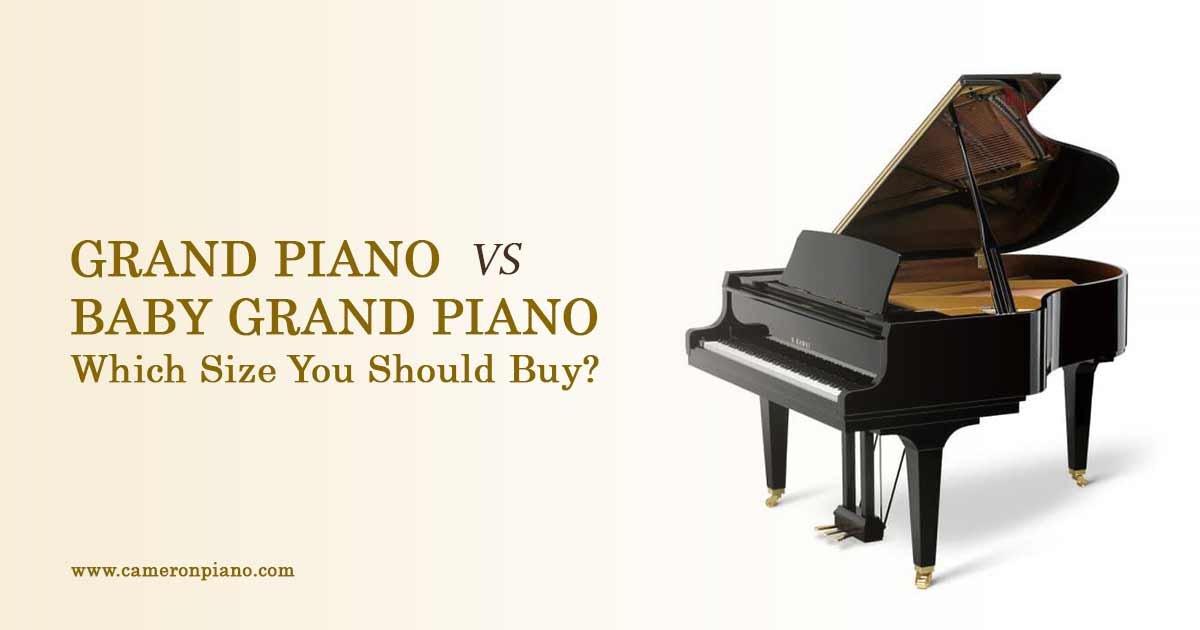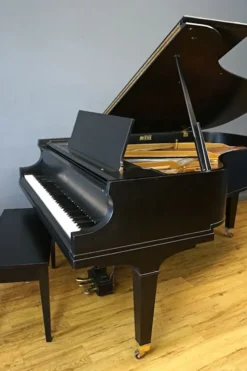News
Baby Grand vs Grand Piano, What Size Should I Buy
If you are torn between buying a baby grand or a full grand piano, size matters more than you think. The right size impacts tone, touch, and even how much you’ll enjoy playing it. It also determines whether the instrument will complement your home or completely overwhelm it. So before moving on to actual buying, let’s break down the differences and find out exactly what size you should buy.
Baby Grand vs Grand Piano: Key Differences
A baby grand piano is a smaller version of the grand piano, designed to save space while keeping the same horizontal string and soundboard layout.
Grand pianos, on the other hand, include a range of larger sizes from the parlor grand to the concert grand.
The main difference is length:
- Baby grand pianos are usually 4’7” to 5’8” in length.
- Grand pianos range from over 5’8” to about 9 feet for a full concert grand.
That extra length matters because it affects the size of the soundboard and the length of the strings. These two factors in turn determine the richness of the tone and the overall music quality.
How Does Size Affect Sound Quality in Baby Grand vs Grand Piano?
The size of a piano isn’t just about looks , it’s the core of its sound. The reason is straightforward: string length and soundboard size matter. Longer strings and a larger soundboard allow vibrations to travel more freely, producing greater resonance, sustain, and tonal richness.
It is the main reason that high-quality grands often feature Alpine spruce soundboards, prized for their ability to amplify and enrich sound. When strings vibrate, the soundboard reflects and blends those vibrations with the resonance of other strings, creating overtones that give the piano depth and complexity. This is why each renowned maker such as Steinway, Blüthner, Fazioli, Bösendorfer has patented unique construction designs that give their pianos a distinct “voice.”
- In a baby grand piano, the shorter bass strings mean the lower notes have less depth and power. The tone is still warm and balanced, but it’s optimized for intimate spaces.
- A grand piano, with its extra length, allows the bass to ring fuller and the treble to sparkle with more clarity. That’s why a concert grand can fill a hall with rich, layered sound , the instrument is physically built for projection and dynamic range.
Does Room Size Decide Whether You Should Buy a Baby Grand or Grand Piano?
Yes and it should be the first factor you consider. A grand piano that’s too large for your room won’t just dominate the space visually , it can also create acoustic problems. Scientific studies on the acoustics of piano reveal that larger pianos need more space for their sound waves to fully develop. If the room is too small, the reflections can cause the tone to become harsh or boomy, especially in the bass range.
- As a rule of thumb, the total wall length of your room should be at least 10 times the length of a grand piano for solo playing, and 15 times for ensemble playing. For example, a 7-foot grand would need roughly 70 feet of wall length. Whereas, a 5-foot baby grand needs roughly 50 feet of total wall length for optimal sound.
- A baby grand will give you elegance and rich tone without overpowering a small room.
On the other hand, a full grand will shine in a larger space, where it can project its sound naturally without bouncing harshly off nearby walls.
Also, measure doorways, hallways, and staircases before purchase as delivery logistics can be a bigger challenge than room acoustics.
Cost Comparison of Baby Grand vs Grand Piano
When it comes to new pianos, it’s natural to assume a baby grand will cost less than a full-sized grand. After all, it’s shorter and uses fewer materials. However, the labor cost tells a different story. In the upper tiers of craftsmanship, think Fazioli, Blüthner, Steinway, a baby grand can take nearly the same hundreds or thousands of hours to build as a larger grand.
As a result, the price difference at this level is often modest, though the larger model will almost always cost more.
In mass-produced models, where parts of the process are machine-assisted, the price gap becomes more noticeable. Here, size, technology, and features all play a role.
| Category | Baby Grand Price Range* | Grand Piano Price Range* | Notes |
| Premium Brands | $70,000–$150,000 | $100,000–$300,000+ | Smaller price gap due to high labor cost |
| Mid-Range Brands | $15,000–$40,000 | $30,000–$80,000 | Larger difference due to size and features |
| Used Market | $5,000–varies | $10,000–varies | Condition & age matter most |
Does Your Playing Level Influence What Size Piano You Should Buy?
Absolutely. If you are a beginner or intermediate player, a high-quality baby grand can more than meet your needs. It will still provide the touch and tone advantages of a grand over an upright.
Advanced pianists, concert performers, and serious students will benefit from the expanded range and dynamic control of a larger grand. This is especially true if you perform in public or record music professionally.
What About Maintenance Costs for Baby Grand vs Grand Piano?
Both baby grands and full grands require regular tuning, at least twice a year. However, larger pianos may have slightly higher maintenance costs due to more strings and higher string tension.
Also, larger grands are heavier, so moving them is more expensive. Humidity control is crucial for both sizes to prevent warping and maintain tuning stability.
So, Baby Grand or Grand Piano – Which Should You Buy?
Here’s the decision checklist:
- Space: Small room = baby grand piano (5’3”–5’7”). Large, open room = grand piano 6 feet or more.
- Budget: Baby grands cost less to buy, maintain, and move.
- Sound Goals: Richer bass and power come from the longer strings of a larger grand.
- Playing Level: Casual players thrive on a baby grand. Pros benefit from a full grand’s range.
- Style Statement: Over 6 feet makes a bold visual and acoustic impact.
Most home pianists find a 5’3”–5’7” baby grand balances sound, space, and cost. If you have the room, a 6-foot grand offers a clear tonal upgrade.
Placement and Acoustic Tips for Baby Grand vs Grand Piano
- Angle for projection: Avoid pushing your piano into a corner. Instead, position it at about 45 degrees with the bass side against an interior wall to enhance sound projection.
- Leave room to play: Keep at least 2 feet of space behind the bench for comfortable seating and movement.
- Protect from damage: Place your piano away from direct sunlight, windows, or air vents to prevent warping and maintain tuning stability.
- Improve room acoustics: In smaller or echo-prone rooms, use rugs, curtains, or non-parallel walls to soften reflections and reduce harsh tones.
These tips apply whether you choose a baby grand piano or a larger grand piano, ensuring your instrument both looks and sounds its best in your space.
Final Thoughts
Choosing between a baby grand and a larger grand piano is more than a question of price. It’s about matching the instrument to your space, playing style, and long-term goals. A well-chosen piano will not only sound great — it will inspire you to play more often. So measure twice, listen carefully, and let your music decide.

 Baldwin Model L Artist Series Grand Piano Ebony Black
Baldwin Model L Artist Series Grand Piano Ebony Black




